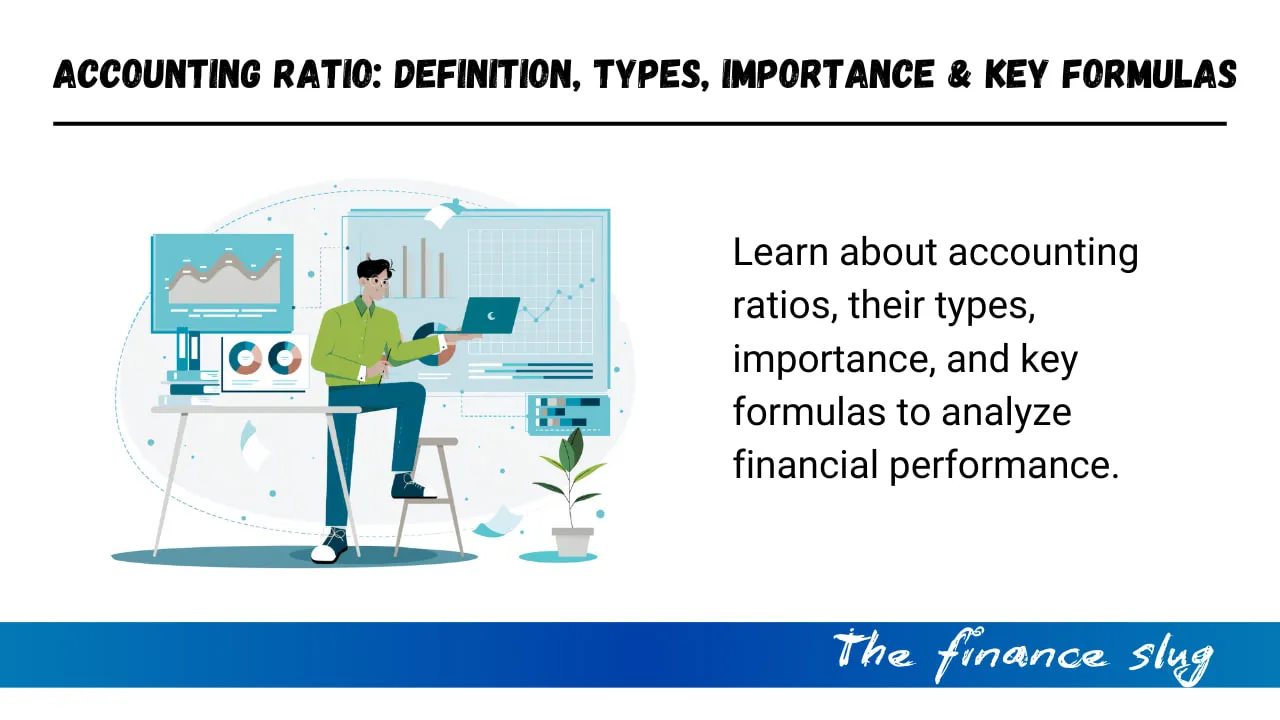
Introduction to Accounting Ratios
Accounting ratios are crucial tools for analyzing a company’s financial performance. They help investors, analysts, and business owners assess profitability, liquidity, efficiency, and solvency. By comparing different financial statement elements, accounting ratios provide insights into a company’s financial health and operational efficiency.
In this blog, we will dive deep into accounting ratios, their types, importance, and formulas to help you understand how to evaluate a company’s financial standing effectively.
What is an Accounting Ratio?
An accounting ratio is a quantitative tool used to assess the financial performance of a company. It compares various financial data points to measure profitability, liquidity, efficiency, and solvency. These ratios are derived from financial statements like the balance sheet, income statement, and cash flow statement.
Key Functions of Accounting Ratios
- Measure a company’s financial stability
- Evaluate operational efficiency
- Compare financial performance across companies and industries
- Assist in decision-making for investors, creditors, and management
Types of Accounting Ratios
Accounting ratios are broadly classified into four main categories:
1. Liquidity Ratios
Liquidity ratios measure a company’s ability to meet its short-term obligations. These ratios indicate how easily a company can convert assets into cash.
Common Liquidity Ratios:
- Current Ratio: Current Assets÷Current Liabilities
- Quick Ratio (Acid-Test Ratio): Current Assets−Inventory÷Current Liabilities
- Cash Ratio: Cash and Cash Equivalents÷Current Liabilities
Importance:
- Helps in assessing short-term financial stability
- Useful for creditors and lenders to determine a company’s creditworthiness
2. Profitability Ratios
Profitability ratios determine a company’s ability to generate profit relative to its revenue, assets, or equity.
Common Profitability Ratios:
- Gross Profit Margin: Gross Profit÷Revenue×100
- Net Profit Margin: Net Profit÷Revenue×100
- Return on Assets (ROA): Net Income÷Total Assets×100
- Return on Equity (ROE): Net Income÷Shareholder’s Equity×100
Importance:
- Helps investors assess a company’s ability to generate profit
- Indicates operational efficiency and financial health
3. Efficiency Ratios
Efficiency ratios measure how well a company utilizes its assets and liabilities to generate revenue.
Common Efficiency Ratios:
- Inventory Turnover Ratio: Cost of Goods Sold÷Average Inventory
- Accounts Receivable Turnover Ratio: Net Credit Sales÷Average Accounts Receivable
- Asset Turnover Ratio: Net Sales÷Total Assets
Importance:
- Shows how efficiently resources are used
- Helps businesses improve their operational strategies
4. Solvency Ratios
Solvency ratios assess a company’s long-term ability to meet its financial obligations.
Common Solvency Ratios:
- Debt-to-Equity Ratio: Total Debt÷Total Equity
- Interest Coverage Ratio: Earnings Before Interest and Taxes (EBIT)÷Interest Expense
- Debt-to-Asset Ratio: Total Debt÷Total Assets
Importance:
- Determines financial stability in the long run
- Helps investors and lenders assess a company’s risk
Also Read : Accounting Rate of Return (ARR) – Formula, Calculation & Importance
Why Are Accounting Ratios Important?
Accounting ratios are essential for businesses, investors, and financial analysts. Here’s why:
- Assess Financial Health: Ratios help measure a company’s ability to manage debt, assets, and liquidity.
- Investment Decisions: Investors use ratios to compare companies before investing.
- Operational Efficiency: Management can use efficiency ratios to improve business operations.
- Creditworthiness: Lenders and creditors analyze solvency and liquidity ratios before granting loans.
How to Use Accounting Ratios Effectively?
To make the most of accounting ratios:
- Compare with Industry Standards: A ratio alone is not useful unless compared with industry benchmarks.
- Analyze Trends Over Time: Monitoring ratios over different periods gives insights into financial trends.
- Use Multiple Ratios Together: No single ratio provides a complete picture; a combination offers better insights.
- Consider External Factors: Market conditions, economic changes, and company strategies also affect financial ratios.
Conclusion
Accounting ratios are powerful tools that help assess a company’s financial performance and stability. Understanding liquidity, profitability, efficiency, and solvency ratios allows businesses and investors to make informed decisions. By using accounting ratios effectively, companies can optimize their financial strategies, manage risks, and drive growth.
Also Read : What Is Accounting Profit? Definition, Formula & Importance
Frequently Asked Questions (FAQs)
1. What is a good ARR percentage?
A good ARR varies by industry, but generally, a higher percentage indicates a more profitable investment. Companies often compare ARR to their required rate of return or industry benchmarks.
2. How is ARR different from ROI?
ARR focuses on accounting profits, while Return on Investment (ROI) considers total profits, including cash flows. ROI also typically accounts for the time value of money.
3. Can ARR be negative?
Yes, ARR can be negative if the project generates losses instead of profits. A negative ARR suggests the investment is not financially viable.
4. Why do businesses still use ARR despite its limitations?
ARR is simple to calculate and does not require detailed cash flow projections, making it useful for quick comparisons and preliminary investment screening.
5. How does depreciation affect ARR?
Depreciation reduces accounting profits, lowering the ARR percentage. Different depreciation methods can impact ARR calculations significantly.
Stock Market Crash Today: A Bloodbath on Monday – What You Need to Know
Published on financeslug.xyz The global financial markets are reeling from a massive sell-off, and Indian…
Wall Street Bonuses Reach Record $47.5 Billion in 2024, Up 34% from Previous Year
How to Convert Delimited CSV Data into Columns in Excel
CSV (Comma-Separated Values) files are widely used for data exchange, but when opened in Excel,…
Harvard University Announces Free Tuition for Families Earning $200K or Less
Harvard’s New Tuition-Free Policy: What You Need to Know Harvard University has unveiled a groundbreaking…
Eli Lilly’s 1.8B Dollar Investment in Weight Loss Drugs
Ireland’s Weight-Loss Drug Boom: A Game-Changer for Economy and Healthcare Ireland is witnessing a surge…
Forever 21 Files for Bankruptcy Again: The End of an Era in Fast Fashion?
Forever 21, once a staple in American malls and a leader in the fast-fashion industry,…








Любите Сникерс? А нежный и ароматный раф кофе? А что если совместить все это в одном напитке? На первый взгляд кажется, что такие диковинки нужно искать только в новых кофейнях. Но в реальности нет ничего сложного в том, чтобы приготовить раф самостоятельно
Блог